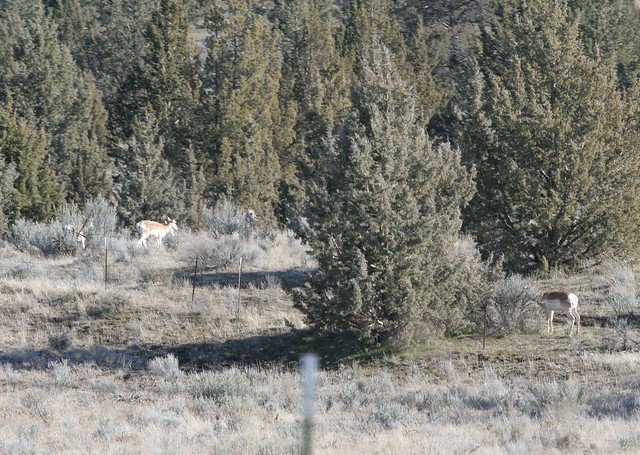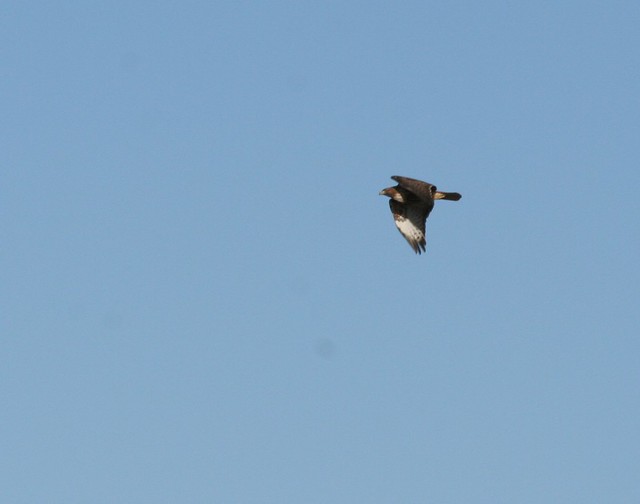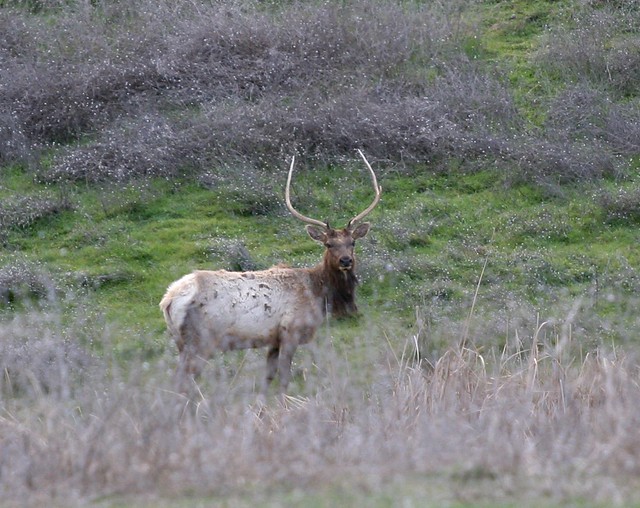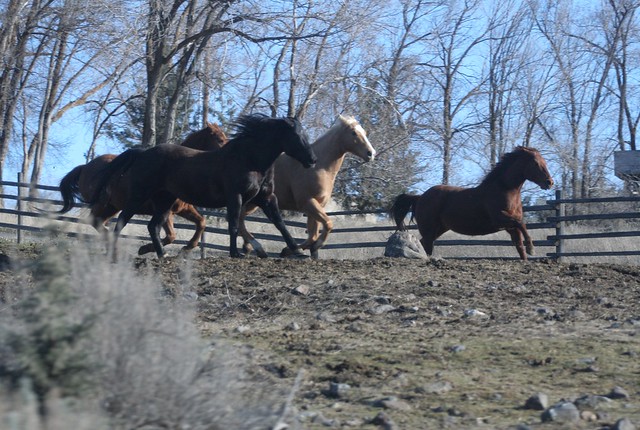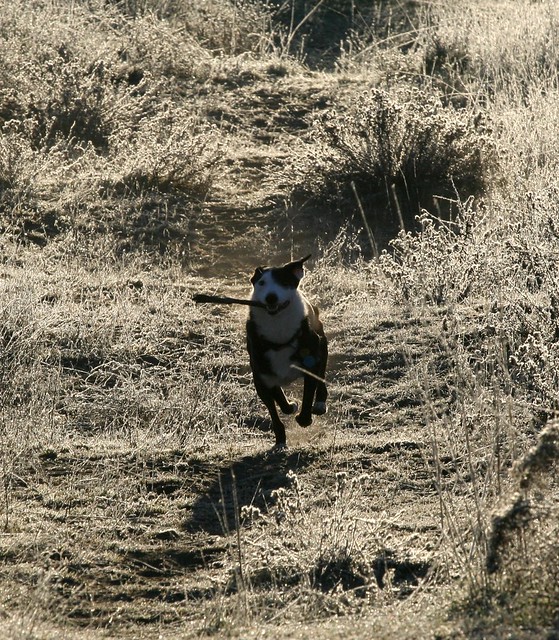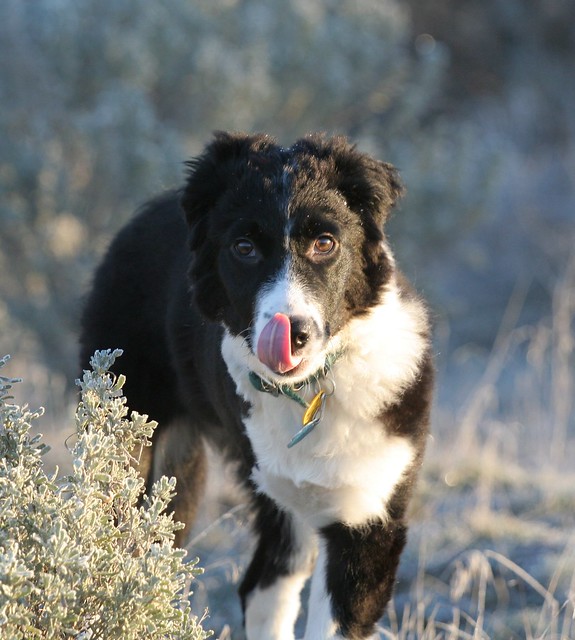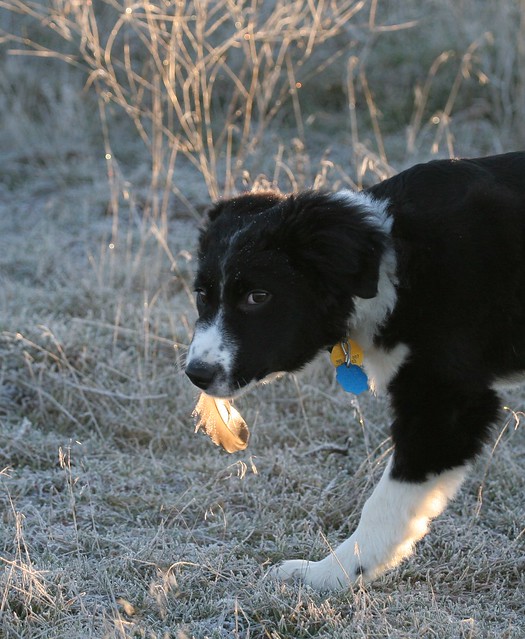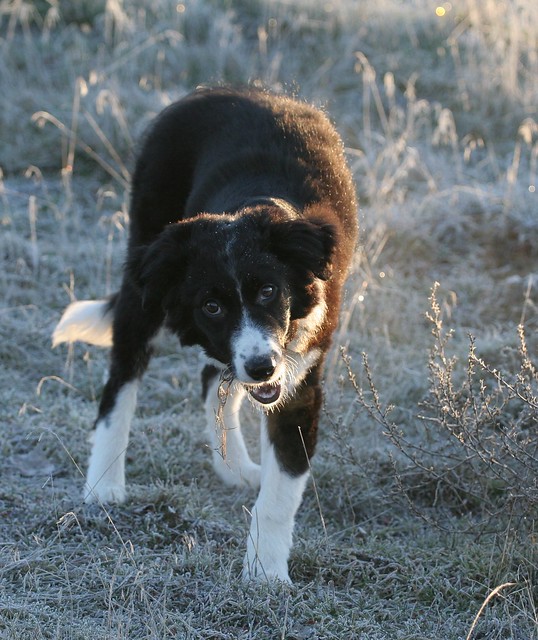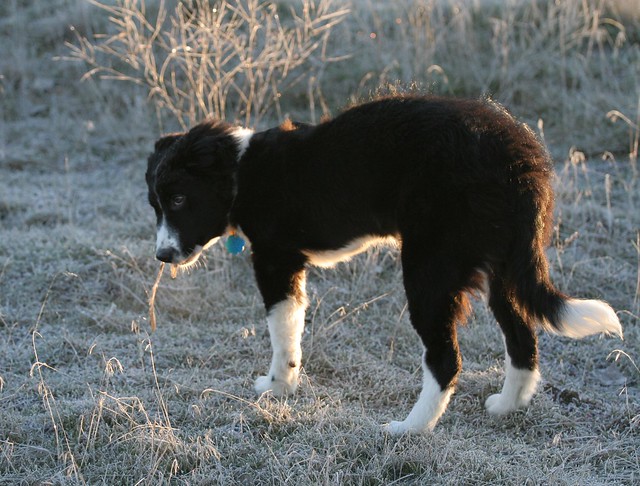
Thursday, February 24, 2011
Tuesday, February 22, 2011
A Trip to Gramma's

It's not every day your gramma celebrates her 90th birthday. It's an event we couldn't miss. We traveled on the west side of the Cascades on the way down, and on the east side on the way up. Tom, amazingly, drove the entire way, even after the gagillionth time I had him pull over for a photo op.
The scenery:

Somewhere in the Siskiyou Mountains, CA

Windmills near Wasco, OR

Near Butte Valley, CA

Lone shack near Shaniko, OR
The Anecdotal Pit Bull #12, 13, 14, and Bonus
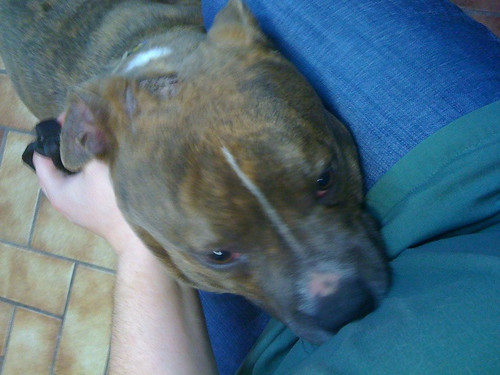
I forget her name. She's a 8 month old American pit bull terrier, brought in by her owner to treat some skin issues. She was very friendly, and pretty mellow. I had to hold her down while the vet painfully scraped her skin in muliple places. She struggled a little but otherwise didn't complain.
Number 13 has no photo because I was too busy to take one. I'll include it in this little series of mine because he was very clearly a "pit bull type" dog and I spent some time handling him. Teko is a white, 7 year old female spayed "pit bull mix" brought in for an annual exam and vaccines. Her owner, a local rancher, has owned her since she was a puppy. She was quite nervous, and when I came out to the waiting room and made brief eye contact with her, she ducked under the bench. When we lifted her onto the examine table, she started shaking slightly and didn't stop until we were done. Despite that, she never acted aggressive or attempted to bite.
Number 14 also has no photo for the same reasons. His owner brought him in to treat a persistent cough. He's a 6 year old, unaltered male American pit bull terrier with a ridiculously and disproportional large head. White with brindle spots. He was very happy and friendly to everyone. He obviously was untrained and not used to being forced to hold still, (and and 65 lbs of pure muscle, difficult to hold as well) but at no point did I feel unsafe holding him.

And here's the Bonus! This is a list of all the patients at this clinic that are listed in our computer records as "American pit bull terrier". The total number: 268. This does not include "American Staffordshire terrier", "Staffordshire bull terrier", "pit bull mix", any dogs whose owners didn't bother giving us a breed, nor any of the boxer, lab, and bull dog mixes that would be targeted by breed specific legislation under the right circumstances. The search program isn't used very often and seems to be buggy, also I don't have time (or permission) to do some really good digging into breed numbers. But I'd like to. But in the meantime, this should give some pretty compelling preliminary (and anecdotal) evidence that "pit bull type" dogs are popular pets.
Wednesday, February 16, 2011
Gotta run
Sunday, February 13, 2011
Monday, February 7, 2011
Cyphenothrin use on dogs, EPA wusses out
So the US EPA not to long ago put out this press release about spot-on flea products for pets. The current webpage is located here: http://www.epa.gov/pesticides/health/flea-tick-control.html
The original webpage at the above address (which I'm unable to find on archive sites, I wish someone had a copy) actually had a very short list of products under investigation because, and I'm paraphrasing here, of the high incidence of reported adverse effects associated with them.
My personal guess is that the handful of companies whose products were on that list had a hissy fit. So the EPA replaced it with a long list of every possible flea product, saying:
"Since the chart previously located on this page reflected only a portion of the numerous pet spot-on products available, EPA felt that pet owners and consumers might be led to believe that only those products listed were the focus of concern. In fact, EPA is intensifying its evaluation of all spot-on products and is providing a more comprehensive list of these products."
I remember very clearly the name of one of the products that was on the original short list. Sergeant's Cyphenothrin + IGR Squeeze on for Dogs (AKA Sergeant's Gold) I even remember the EPA registration number (2517-80). It's an over-the-counter spot-on that contains a ridiculously high amount (40%) of the pyrethroid cyphenothrin (known effects of over-exposure in mammals: skin irritation, muscle twitching, and in extreme cases, seizures).
It's a relatively new product. It's first approval date was late 2006 (according to PPLS http://oaspub.epa.gov/pestlabl/ppls.home ).
Take a look at this internal EPA memorandum that was recently released under FOIA:
http://www.epa.gov/opp00001/foia/reviews/129013/129013-2005-06-27a.pdf
The memo talks about two studies. The first one was to look for possible adverse effects. The results were what you get effects like what you'd expect from a flea product of normal risk: groups of dogs given the normal dose didn't have adverse effects, but over dosing did cause problems.
The second study (which was looking at efficacy of product to kill fleas like the label claims and only observed health effects as a side note), all dogs given a normal dose had very bad (and consistent) adverse reactions. This is bad. This is a HUGE inconsistency and should have stopped the approval of this product cold until it could be resolved. It's so fishy I can smell it.
"There are obviously then some significant inconsistencies between the findings in the companion animal safety study in MRID 46166108 and the efficacy study in MRID 46166109. The occurrence of neurological signs of toxicity in all 6 dogs in the efficacy study suggests that there is not even a 2x margin of safety associated with the proposed application rate of 1.17 mL"
Note the studies mentioned in the memo have numbers instead of titles. This usually means that they are unpublished and not available to the public. This is not out of the ordinary, EPA requires pesticide companies to submit studies like this all the time. The strict laboratory standards (GLP) are supposed to stop any falsifying of data.
Why did they ignore this inconsistency? Why did the product go on the market without change to the formula? The only thing that may be different is the size of the application.
The actual approved product labels on PPLS list application tube sizes as 1.5mL (making it the 1.17mL dose) (9-20 lbs dogs) 3.0mL (expected dose: 2.34mL)(21-39 lbs) 4.5mL (expected dose 3.51mL)(40-60lb) and 6.0 mL (60+ lb).
These sizes seem to be at or larger than the doses in the study that caused 100% of dogs to have serious reactions. In fact, the memo says that the proposed label dose should be 1.17 mL of a 40% concentration. I'm confused by this, and I'm wondering if I'm missing something. It looks like they INCREASED the dose for the actual product. To meet efficacy requirements? If so, that's nuts.
The efficacy study gave higher doses than the safety study, also. so that makes more sense.
I wonder, of course, if there was an error with the study. The actual concentration used was higher than reported. Still. This known inconsistency, combined with the fact that the product contains a very high concentration of cyphenothrin AND that the product appears to get more than it's fair share of adverse effects reports should be a big ol' red flag.
Why is EPA being all wishy washy and not singling this product out in public? They haven't had a problem with that in the past. A stop sale should have happened months ago, in my humble opinion. Get it sorted, if it turns out the adverse effects reports are within normal risk range, then let the company continue to sell. If not, do what FIFRA says is supposed to happen, and make them re-evaluate their dosing and concentrations.
The original webpage at the above address (which I'm unable to find on archive sites, I wish someone had a copy) actually had a very short list of products under investigation because, and I'm paraphrasing here, of the high incidence of reported adverse effects associated with them.
My personal guess is that the handful of companies whose products were on that list had a hissy fit. So the EPA replaced it with a long list of every possible flea product, saying:
"Since the chart previously located on this page reflected only a portion of the numerous pet spot-on products available, EPA felt that pet owners and consumers might be led to believe that only those products listed were the focus of concern. In fact, EPA is intensifying its evaluation of all spot-on products and is providing a more comprehensive list of these products."
I remember very clearly the name of one of the products that was on the original short list. Sergeant's Cyphenothrin + IGR Squeeze on for Dogs (AKA Sergeant's Gold) I even remember the EPA registration number (2517-80). It's an over-the-counter spot-on that contains a ridiculously high amount (40%) of the pyrethroid cyphenothrin (known effects of over-exposure in mammals: skin irritation, muscle twitching, and in extreme cases, seizures).
It's a relatively new product. It's first approval date was late 2006 (according to PPLS http://oaspub.epa.gov/pestlabl/ppls.home ).
Take a look at this internal EPA memorandum that was recently released under FOIA:
http://www.epa.gov/opp00001/foia/reviews/129013/129013-2005-06-27a.pdf
The memo talks about two studies. The first one was to look for possible adverse effects. The results were what you get effects like what you'd expect from a flea product of normal risk: groups of dogs given the normal dose didn't have adverse effects, but over dosing did cause problems.
The second study (which was looking at efficacy of product to kill fleas like the label claims and only observed health effects as a side note), all dogs given a normal dose had very bad (and consistent) adverse reactions. This is bad. This is a HUGE inconsistency and should have stopped the approval of this product cold until it could be resolved. It's so fishy I can smell it.
"There are obviously then some significant inconsistencies between the findings in the companion animal safety study in MRID 46166108 and the efficacy study in MRID 46166109. The occurrence of neurological signs of toxicity in all 6 dogs in the efficacy study suggests that there is not even a 2x margin of safety associated with the proposed application rate of 1.17 mL"
Note the studies mentioned in the memo have numbers instead of titles. This usually means that they are unpublished and not available to the public. This is not out of the ordinary, EPA requires pesticide companies to submit studies like this all the time. The strict laboratory standards (GLP) are supposed to stop any falsifying of data.
Why did they ignore this inconsistency? Why did the product go on the market without change to the formula? The only thing that may be different is the size of the application.
The actual approved product labels on PPLS list application tube sizes as 1.5mL (making it the 1.17mL dose) (9-20 lbs dogs) 3.0mL (expected dose: 2.34mL)(21-39 lbs) 4.5mL (expected dose 3.51mL)(40-60lb) and 6.0 mL (60+ lb).
These sizes seem to be at or larger than the doses in the study that caused 100% of dogs to have serious reactions. In fact, the memo says that the proposed label dose should be 1.17 mL of a 40% concentration. I'm confused by this, and I'm wondering if I'm missing something. It looks like they INCREASED the dose for the actual product. To meet efficacy requirements? If so, that's nuts.
The efficacy study gave higher doses than the safety study, also. so that makes more sense.
I wonder, of course, if there was an error with the study. The actual concentration used was higher than reported. Still. This known inconsistency, combined with the fact that the product contains a very high concentration of cyphenothrin AND that the product appears to get more than it's fair share of adverse effects reports should be a big ol' red flag.
Why is EPA being all wishy washy and not singling this product out in public? They haven't had a problem with that in the past. A stop sale should have happened months ago, in my humble opinion. Get it sorted, if it turns out the adverse effects reports are within normal risk range, then let the company continue to sell. If not, do what FIFRA says is supposed to happen, and make them re-evaluate their dosing and concentrations.
Tuesday, February 1, 2011
Why can't we just let 'em be?

Image: English ivy devours a forest in Portland, Oregon
I have a treat for you tonight, dear readers. An internet exclusive. I am happy to share this original song written, composed, performed, and recorded by Tim Karplus. My brother-in-law is a talented musician with a background in science and a quirky sense of humor. It's hard to beat that combination.
I could rant 'til I'm red in the face about the horrors of invasive species. Funny how putting it into simple song has so much more impact.
Click here to listen.
(If you're using Internet Explorer, it will probably ask you to download. I'm sorry that you use a browser that sucks eggs).
Lyrics:
Why won't we let 'em be?
Invasive species
Don't seem so bad to me
If they can outcompete and beat our native plants
Then I won't miss them
But what about that delicate balance
Our ecosystem?
Invasive species
Why won't we let 'em be?
'Cause they're a threat to
Biodiversity
English holly and Scotch broom
Tree Ivy leaves no room
For all the native plants
Thank you in advance
For making their home their home again
Invasive species
Why won't we let 'em be?
'Cause they're a threat to
Biodiversity
Invasive species
Why won't we let 'em be?
'Cause they're a threat to
Biodiversity
Subscribe to:
Posts (Atom)




